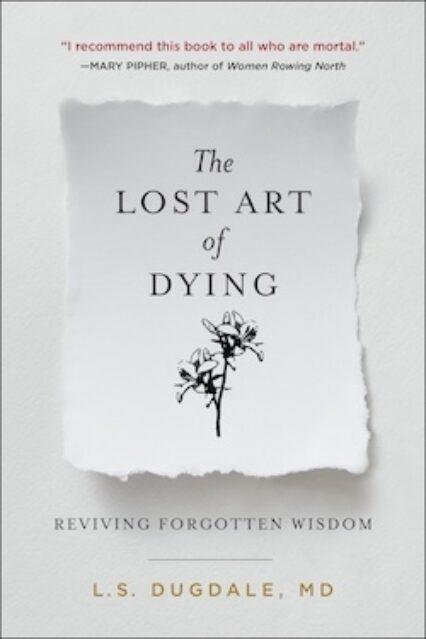Getty/dimid_86
Lydia Dugdale, author of The Lost Art of Dying, on the art of dying and why we should instead face our finitude squarely—while we still can.
For most of the past century, we in the West have lived as though death were optional—or at least largely avoidable. But the pandemic has challenged this notion. COVID-19 has brought into relief the threat of mortality in a way that few Americans have ever experienced it. Daily mortality counts and mobile morgues have made death a reality. The question is: What should we do about it?
The dominant reaction has been instinctual—fight the virus and run from death. We have thrown the best of Western medicine at COVID: searching for vaccines, treatments, cures. We have stayed home. We wear masks and maintain a safe social distance. And we have long since stopped gathering at theaters, restaurants, churches, and schools. All of these efforts have aimed to reduce spread—and, therefore, death.
As a society quick to embrace the cutting edge, what we have failed to realize is that one of the best tools we have for pandemic preparedness is more than 600 years old. That tool is called the ars moriendi, which is Latin for the “art of dying.” The ars moriendi was a body of literature that developed in the aftermath of the mid-14th century outbreak of bubonic plague that ravaged Western Europe. Its earliest iterations consisted of handbooks on how to prepare for death by living well. They contained advice, prayers, and protocols for both the living and the dying. The genre grew enormously popular, and its many variations circulated for half a millennium.
Why should we expect medieval handbooks to help with the coronavirus? The answer, in part, has to do with the fundamental orientation of the ars moriendi. The handbooks understood death as a fact of life. If it weren’t a recurrence of bubonic plague, then famine or war could signal human finitude. People were thus advised to prepare well for death, because it would surely come. This sort of thinking could benefit all of us as the COVID-19 pandemic evolves into COVID-20.
According to the ars moriendi, preparing for death was an art that was meant to be exercised over a lifetime. Practicing the art meant living intentionally and wisely. It required taking stock of and attending to relationships, possessions, anxieties, and spiritual beliefs. People of the late Middle Ages wanted to die well and thus strove to live well, measuring the tasks, goals, and behaviors of any day against mortality itself. “If we are going to die, how then should we live?” they asked one another.
Our approach to coronavirus, by contrast, has been somewhat different. Rather than, “If we are going to die, how should we live?” we have been asking, “To avoid death, how should we live?” The difference is between expecting death versus expecting to avoid death. The latter is a completely different orientation—not wrong per se, but not helpful for the long game.
To be clear, acknowledging human finitude does not mean we wish to die. Nor should a recognition of our mortality imply we behave cavalierly. We still wear seatbelts in cars and masks in public. We still wash our hands. And we still seek a vaccine and treatment. But we also live with the end in view.
How might a revived “art of dying” help us live well in order to die well? There are many ways, but I’ll highlight three—the relational, the physical, and the spiritual.
Relationships: First, the ars moriendi emphasized that the art of living well in order to die well was meant to be practiced within the context of community. The very people with whom we live, work, and play are the same ones with whom we need to be engaging life’s biggest questions. We know that people die best in the context of a nurturing community; indeed, dying has always been a community affair. Why, then, do we believe that we can go it alone throughout life and salvage relational bonds just before we die? Instead, we must work to cultivate our relationships throughout life so that we both live and die better.
The physical body: The rise of modern medicine is partly responsible for the ars moriendi body of literature’s fall from favor in the last century. Cardiac resuscitation, organ transplantation, and cures for cancer drove death from view. But such technology—wonderful as it is—has complicated dying such that many people die highly medicalized deaths, the very kinds of deaths they say they would never want.
An “art of dying” today must force us to reckon with medical technology. We must ask ourselves and our doctors what various interventions and treatments mean for our health now and our dying longer term. During the height of the pandemic, some healthcare practitioners called their sicker patients to let them know that if they caught coronavirus, they very likely would not survive. Because of visitor restrictions, if patients didn’t want to die alone in the hospital, their doctors would assist by setting up a home hospice program. Clinicians would care for them in their homes. Decisions such as these, in addition to decisions about whether or not to forgo chemotherapy, intubation, or resuscitation, are part of preparing well for death.
Spiritual questions: In addition to nurturing relationships and making practical decisions about uptake of healthcare at the end of life, we must also give thought to life’s so-called “big questions” prior to the end. Indeed, attending to the spiritual side of living and dying is every bit as important—if not more so—than attending to the physical. I have cared for countless patients who find themselves withering away in the hospital, clearly dying, and suddenly asking what gives life meaning. If we don’t think about death, we likely won’t give consideration to questions of why we exist, what life is for, and what happens when we die. Dying well requires living well, and part of living well means wrestling with these questions before the end.
The pandemic is far from over, and it will likely consume many more lives. But we are not without resources—relational, physical, and spiritual. The ars moriendi teaches that we should not save this up for the end. We should instead face our finitude squarely—while we still can.

Further explore hopeful perspectives on death and dying—and living with intention—via the lost Medieval practice of ars moriendi in Dugdale’s new book, The Lost Art of Dying.







